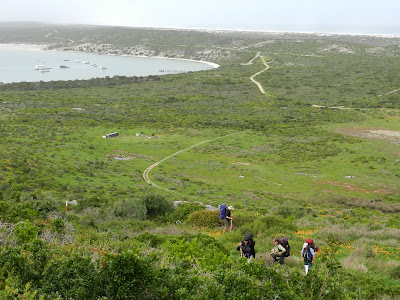WILD COAST MEANDER
The Wild Coast Meander is a hike along the Transkei Coast in
the Eastern Cape. Virtually the entire
coast is an untouched paradise with little development beyond a couple of small
towns and the occasional family-orientated, very comfortable holiday resort. We stayed overnight at beach resorts which offer
hikers a seaview bedroom-en-suite, breakfast, dinner and a packed lunch for the
next day. The meals were a mix of
comfort food, homecooked and healthy at
all the resorts. No junk! Different guides from the local
community lead each group, the cost being part of the package. This puts much needed income into the
wildcoast communities and ensures that your security is looked after, and
porters can be hired at a set, but not inflated, cost.
The July school holidays was the perfect time to do this
walk as it is the time of year with the lowest rainfall. Despite this, there are river mouths every 8km
or so, which are very easy to cross, either barefoot, or by ferry which
costs R1.00 or R2.00 per person. The hike can be done over five nights, with a
night at each beach resort, or longer if you choose to spend more time at one
or more of the resorts.
 |
| Picnic Lunch |
We drove from Cape Town to East London using the taxi
route - N1 to Beaufort West, then through Aberdeen and Graaff-Reinet. I was told that the taxis do not travel to
the Eastern Cape on a Saturday, the day we left, so this was a unanimous first
choice. The N2 has become overcrowded
with traffic and busy towns, and has a constantly changing speed limit with the
inevitable speed traps which all adds up to a stressful journey.
In East London, our booking at Arbour Lodge, Beacon Bay was
good value compared to everything else on offer – R600 for four of us for the
night. At 9.00 am we met
up with Helen from Wild Coast Adventures who had organised secure parking for
our car, lunch packs and a mini-bus to take us to the first overnight stop –
Kob Inn.
 |
| Grassed area in front of the rooms. |
Kob Inn, a 3 ½ hour drive from East London, 32 kms and 45
minutes of which is on a rutted gravel road which is apparently a whole lot
better than it used to be!
Kob Inn is a very attractive beach resort built close to the sea. During the afternoon our daughters went
quadbiking led by the Chef, Dean and we canoed up the Qora River. Sunday supper was a braai served overlooking on the terrace
overlooking the sea – at spring high tide I think we would have been splashed
by waves.
 |
| Cattle herders with their cattle |
Our guide for the first day of hiking, Phillip was an interesting mix of Khoisan, Xhosa and European descent which gave real meaning to the term, Rainbow Nation. He was only too happy to answer all our questions and he told us his family history, as well as Xhosa traditions. As we walked along the coast we became aware of the multi-cultured history of the area, which originally is Khoisan, then mixed with the Xhosa people as they moved further south and the shipwrecked Europeans/Asians as explored in the book “The Sunburnt Queen”, followed by the 1820 settlers from Europe who landed at Grahamstown and the subsequent frontier wars. The first day Kob Inn and Mazeppa Bay is a short walk of 6kms along beach and grassed fields which reach down to the rocks along this coast.
 |
| Ferry crossing! |
 |
| Mazeppa Bay in the distance |
 |
| Waiting for the ferry to cross to the Wavecrest |
 |
| On the way to our tour of the Mangrove Swamps |
 |
| On Trevor's Trail from Trenneries |
 |
| Pontoon across the Great Kei River |
roof. Our packed lunch from Trenneries was the best of all - chicken leg, grilled fish, sandwich and fruit.
The last hotel in Morgan Bay, was a real treat! Morgan Bay Hotel has a spectacular view of the sea from the rooms and we were served an excellent dinner menu which had starters, soup, fish, main course and dessert.
The next day we were picked up and driven back to our car
in secure lockup in East London.
We had a brief stopover in the Sundays River Valley for a
days visit to Addo Elephant Park, and choose the R62 for the drive home.
If you don’t know the R62, choose this route next time
you head up the east coast and visit Ronnies Sex Shop for a lunch stopover. (Not as it sounds!)

































